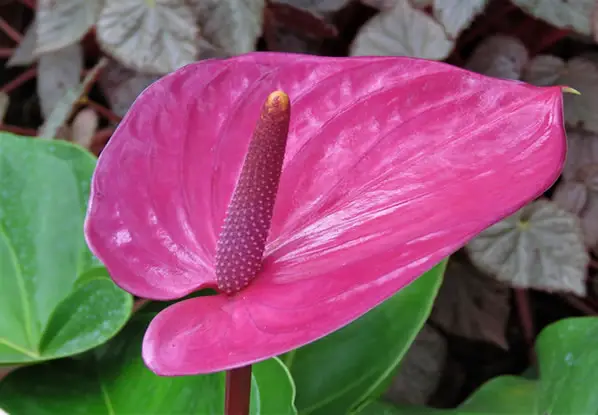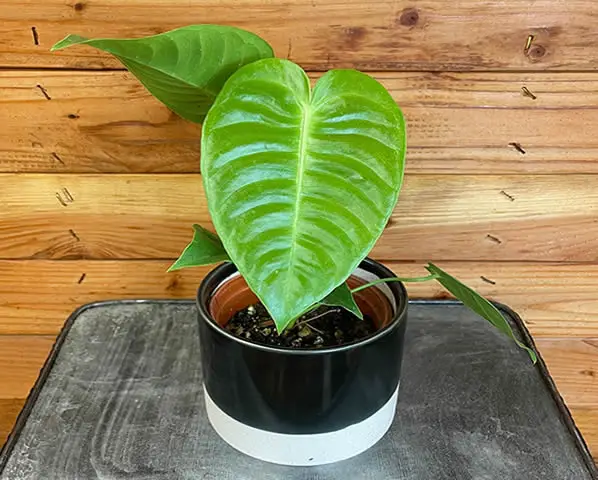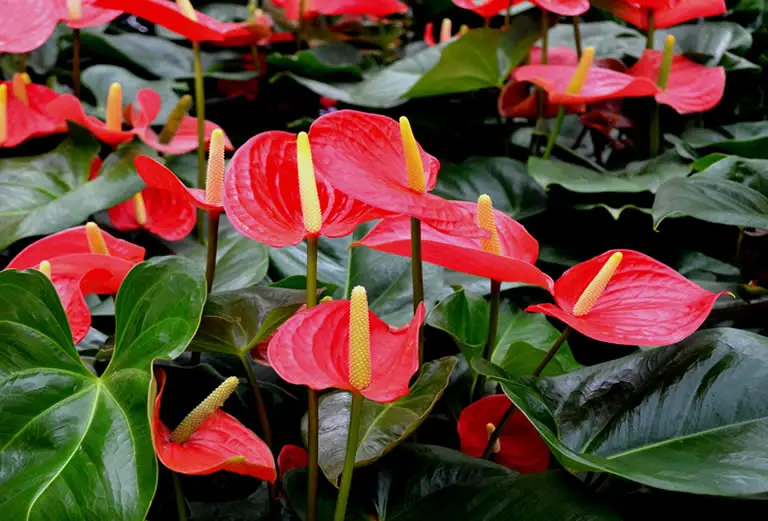Anthuriums are some of the most striking houseplants around, admired for their dramatic foliage and colorful, long-lasting blooms. Among them, Anthurium clarinervium is a real standout—famous for its thick, velvety, heart-shaped leaves etched with silvery white veins. But it’s just one gem in a diverse genus of over 1,000 species.
Whether you’re growing a flowering Anthurium like Anthurium andraeanum or a foliage-forward variety like Anthurium crystallinum, the care guidelines are surprisingly similar. Anthuriums are tropical plants by nature, but with a little know-how, they can flourish beautifully indoors.
Table of Contents
A Quick Note on Variety
Although much of the information in this guide is inspired by the care needs of Anthurium clarinervium, these tips can be applied to a wide range of Anthurium species and hybrids.
Popular Anthurium Houseplants Include:
-
Anthurium andraeanum (Flamingo Flower)
-
Anthurium scherzerianum
-
Anthurium crystallinum
-
Anthurium magnificum
-
Anthurium veitchii (King Anthurium)
-
Anthurium warocqueanum (Queen Anthurium)
-
Anthurium regale
All of these plants thrive with similar care conditions—bright, indirect light, high humidity, and well-draining, chunky soil.
The main differences come down to growth habits and appearance, but the fundamentals remain consistent.
What Makes Anthuriums Unique?
Anthuriums in the Andiphyllum section, such as clarinervium, originate from rocky, shaded outcrops in Mexico and parts of Central America.
They’re lithophytes, meaning they grow on rocks and between cracks in limestone—contrary to the common misconception that they are epiphytes like orchids.

This unique lifestyle is reflected in their root systems. They’re designed for excellent airflow and limited moisture, making these plants prone to root rot in soggy soil but quick to thrive when given the right balance.
Anthurium leaves are often what make them a favorite among plant collectors.
The thick, leathery texture of varieties like clarinervium is unlike anything you’ll find on your average houseplant.
Some leaves even have a suede-like surface and cardboard-like stiffness that adds to their charm.
Light Requirements
While some may say Anthuriums can survive in low light, thriving is a different story.
These plants do best in medium to bright, indirect light. Direct sunlight will quickly scorch their leaves, especially those with delicate, velvety foliage.
Filtered or diffused light is ideal—think dappled sunlight through a sheer curtain or near a bright window that doesn’t receive direct sun.
An eastern-facing window is often perfect, offering gentle morning rays and consistent brightness throughout the day.
A northern window can work too, but if your plant starts to look leggy or its growth slows, it may need a light boost. In west-facing spaces, keep the plant out of reach of the intense late afternoon sun.
South-facing windows tend to be the brightest and warmest, so place your Anthurium a few feet back from the window to keep it comfortable.
During winter, growth slows naturally, so your Anthurium won’t need as much light. Just avoid very dark corners, and you’ll be fine.
Watering
Watering an Anthurium can feel a bit like a balancing act. These plants hate soggy soil but also don’t like to dry out completely.
The sweet spot? Wait until the top one to two inches of soil feel dry, then water thoroughly.

When done right, you’ll likely find yourself watering about once a week—though this depends on the season, humidity, pot size, and material.
Always water deeply, letting excess drain freely from the pot.
This helps flush out any buildup of fertilizer salts and ensures all the roots get a proper drink.
Avoid letting the plant sit in pooled water—this is one of the fastest routes to root rot.
Several factors influence how often your Anthurium needs water:
-
Humidity: Lower humidity means faster drying.
-
Temperature: The warmer it is, the more often you’ll need to water.
-
Pot material: Terracotta dries out quickly; plastic retains moisture longer.
-
Season: During cooler months, let the soil dry out a little more.
Also, keep in mind that Anthuriums can be sensitive to hard tap water.
If your plant’s growth seems slow or the leaf tips start browning, switch to rainwater, distilled water, or filtered water for a noticeable improvement.
Soil Requirements
Soil is one of the most important elements of Anthurium care.
These plants need a growing medium that offers excellent drainage, aeration, and a bit of moisture retention—but not too much.
A traditional potting mix won’t cut it. You’ll need something chunkier.
You can start with an orchid mix and add your own amendments to make it ideal for Anthuriums.
A popular blend includes one-third peat moss or coconut coir, one-third orchid bark, and one-third perlite.
You want a mixture that mimics their native rocky environment—light, airy, and quick to drain.
The pH should be slightly acidic, in the range of 5.5 to 6.5. This allows the roots to absorb nutrients effectively and helps prevent common nutrient deficiencies.
If you’re mixing your own soil, consider adding components like:
-
Cut sphagnum moss
-
Coconut coir
-
Perlite or pumice
-
Orchid bark or wood chips
-
Charcoal (aquarium charcoal works well)
-
Leaf mold or compost (in small amounts)
-
Crushed lava rock or gravel
Some growers even use a base layer of pumice or lava rock to recreate the rocky terrain Anthuriums love.
There’s no single right recipe—just aim for a loose, breathable mix that doesn’t compact and holds just enough moisture to keep the roots hydrated.
Humidity
Humidity isn’t optional when it comes to Anthuriums—it’s essential. These plants originate in humid, tropical climates and need moisture in the air to thrive. While 50% humidity is the minimum they’ll tolerate, they really shine at 60% and above.
In dry indoor environments, especially during winter or in air-conditioned rooms, humidity often drops below this threshold. Thankfully, there are a few simple ways to raise it:
-
Group plants together to create a shared humid microclimate
-
Use pebble trays filled with water under your plant (but not touching the base)
-
Invest in a small room humidifier, which offers consistent and effective moisture
For the most humidity-loving species like Anthurium clarinervium, crystallinum, or warocqueanum, a terrarium or greenhouse cabinet can be a great solution.
These setups maintain stable humidity and make these finicky types much easier to manage indoors.
Temperature
Anthuriums prefer warm, consistent temperatures, ideally between 68°F (20°C) and 80°F (27°C). They don’t respond well to cold drafts or temperature swings.
If temperatures dip below 55°F (13°C), growth will slow dramatically and leaf damage may occur.
Avoid placing your Anthurium near drafty windows in the winter or air conditioners in the summer.
They also don’t like to be placed near radiators or heating vents, which can dry them out and cause brown leaf edges.
If you live in USDA Zones 9 to 11, you might be able to grow Anthuriums outdoors year-round—but always shield them from harsh direct sunlight and cold snaps.
Fertilizing
Despite their bold appearance, Anthuriums aren’t heavy feeders. They come from rocky environments with minimal soil, so a light hand with fertilizer is best.
Use a balanced houseplant fertilizer—something like 20-20-20—at quarter to half strength every 4 to 6 weeks during the growing season (spring through early fall).
During the cooler months, you can skip feeding altogether. Overfertilizing is a common mistake and can lead to salt buildup in the soil, which damages roots.
That’s why it’s helpful to flush the soil thoroughly every couple of months, allowing excess salts to wash out.
Both synthetic and organic fertilizers can work. Organics are gentler and support microbial life in the soil, while synthetics offer more control and predictability.
Flowering and Berries
If you’re growing an Anthurium for its foliage, don’t expect much from its blooms.
Anthurium clarinervium, for example, produces modest flowers—typically pale green with a touch of violet on a spadix.
They’re not particularly showy, but they can eventually produce berries.
Berry development happens only if the flower is pollinated, which requires a bit of help indoors. Even then, it can take over a year for the berries to fully ripen.
The plant usually needs to be at least two or three years old before it’s mature enough to bear fruit.
Many growers simply trim off the flower to conserve the plant’s energy.
Pruning
Anthuriums are relatively low-maintenance when it comes to pruning. You won’t need to do much beyond basic grooming, like removing dead or damaged leaves.
If a leaf has some browning or spots but is otherwise healthy, you can trim away just the affected area and leave the rest until new growth comes in.
To prune properly, use clean, sharp scissors or pruning shears and cut close to the base of the leaf stem.
Some plant owners gently snap off aging leaves by pressing down at the base until they pop away, but use caution—this method works best only when a leaf is already on its way out.
Leggy plants can also be pruned to promote fuller growth, but Anthuriums naturally grow a bit spaced out, especially as they mature.
Repotting
Most Anthuriums need to be repotted every two to three years.
That said, the best indicator is when the roots begin circling the inside of the pot or growing out of drainage holes.
A snug pot supports healthy foliage growth, but once it becomes overcrowded, the plant will need more space.
Repotting is also a great opportunity to refresh the soil and remove any rotted or dead roots.
Anthuriums don’t like their roots disturbed, so be as gentle as possible.
Keep these repotting tips in mind:
-
Water a day beforehand to help ease the plant out
-
Use a pot just 1–2 inches larger in diameter than the current one
-
Keep the crown of the plant at the same depth—not deeper
-
Water after planting to settle the soil
-
Skip fertilizing for at least a month after repotting
Clarinerviums and similar varieties may cling to clay pots due to their firm, gripping roots.
If removal causes too much damage, it’s better to gently break the pot than force the plant out.
Propagation
Anthuriums can be propagated three ways: by seed, division, or stem cuttings.
Seeds are the slowest method. You’ll need to hand-pollinate the flowers and wait months for berries to form and ripen.
When they’re ready, simply remove the seeds from the orange berries and plant them in a fine, moist mix.
High humidity and warmth will give them the best shot at germination.
Division is the easiest and most reliable method.
When repotting, gently separate a section of the plant that has roots and at least one leaf, and pot it up in fresh soil.
Stem cuttings can work but require some patience.
Take a 4–6 inch cutting with aerial roots attached, treat the cut with cinnamon or rooting hormone if desired, and plant it in a chunky soil mix. Provide warmth, humidity, and bright indirect light as the cutting settles in. It may take several weeks before you see new growth.
Pests and Diseases
Anthuriums are surprisingly tough when it comes to pests and disease, but a few issues can still pop up.
Mealybugs are the most common pest. These small white insects gather at leaf joints and under foliage.
Use insecticidal soap, neem oil, or diluted dish soap to wipe them off, and rinse the plant with lukewarm water after treatment.
Scale can be more stubborn, often requiring rubbing alcohol on a cotton swab to remove. Repeat treatments may be needed.
Fungal or bacterial issues typically come from overwatering or poor airflow.
Always let excess water drain out, avoid letting water sit on the leaves, and provide good air circulation.
Routine care goes a long way in keeping your Anthurium healthy.
Keep an eye out for unusual spots, sticky residue, or pests under the leaves, and act quickly if you see anything suspicious.
Extra Care Tips
Every Anthurium needs time to adjust to new surroundings.
Whether it’s fresh from the nursery, coming out of a repotting, or recovering from a big move, don’t be alarmed if it wilts slightly or drops a few leaves. Give it a little time, and it should bounce back with new growth.
Avoid fertilizing during periods of stress—wait until the plant is actively growing again.
Yellowing leaves can be a sign of overwatering, too much light, or even nutrient issues. Assess its light exposure, soil moisture, and water quality before making any changes.
Some Anthuriums will produce water droplets at the leaf tips, a process called guttation.
It’s not harmful but might leave spots on your furniture or floors, so you may want to use a saucer or place a towel beneath your plant if this happens.
If you’d like to bring your Anthurium outdoors in the summer, choose a shaded spot protected from wind.
Taller or leggier plants can break at the crown in high winds, so give them extra support with a bamboo stake or plant pole. Just be sure to bring them back inside before temperatures fall.
Air circulation is another underrated care factor. Anthuriums love fresh, moving air, but not direct drafts. Avoid placing them near heaters, air vents, or drafty windows.
Toxicity
All Anthuriums, including clarinervium, are mildly toxic to both humans and pets. They contain calcium oxalate crystals, which can irritate the mouth, throat, and digestive system if ingested.
Common signs of poisoning include:
-
Drooling (especially in pets)
-
Pawing at the mouth
-
Vomiting
-
Lack of appetite
-
Oral irritation
Serious effects are rare but can happen, especially in smaller pets. It’s best to keep your Anthurium out of reach of curious cats, dogs, and children.
On the upside, this mild toxicity also makes them unappealing to most wildlife like rabbits or deer.
Varieties and Lookalikes
Anthurium clarinervium belongs to a group of velvety, heavily veined species often called “Esqueleto” Anthuriums, meaning “skeleton” in Spanish.
That’s thanks to their pale, prominent leaf veins that resemble a ribcage.
You may come across the name Anthurium clarinervium matuda, but it refers to the same plant—there’s only one true variety. However, numerous hybrids and individual plants may have slightly different vein patterns or leaf shapes.
A common lookalike is Anthurium crystallinum, which has thinner, more translucent leaves and slightly brighter veins.
Clarinervium leaves are thicker and often a bit smaller and rounder. Both are stunning and often mistaken for each other.
Final Thoughts
Anthuriums might seem like high-maintenance houseplants, but once you’ve dialed in their needs—bright, indirect light, high humidity, chunky soil, and careful watering—they’re actually quite forgiving.
With the right conditions, they’ll reward you with rich foliage and a strong, tropical presence that makes them the focal point of any space.
Whether you’re a collector chasing after rare varieties or just want one reliable houseplant that turns heads, Anthuriums are a beautiful investment in your indoor jungle.

